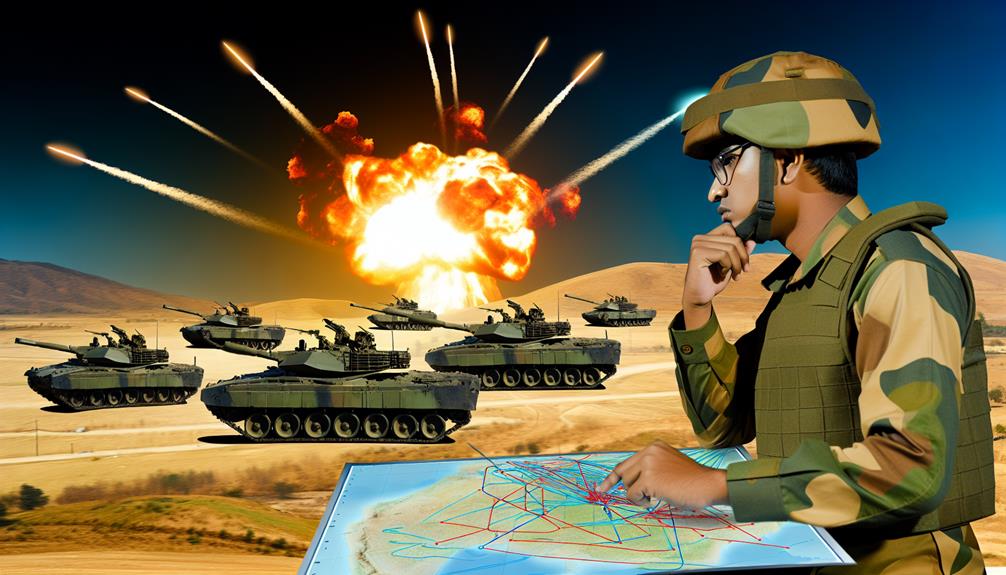To master your strategy in "Age of Tanks," you must thoroughly understand unit types, their strengths, and battlefield dynamics. Main Battle Tanks act as the backbone, while Light Tanks offer speed for reconnaissance. Terrain influences effectiveness, requiring careful positioning for ideal engagement. Resource management is crucial; prioritize assets that present a tactical advantage. Finally, effective team coordination enhances operational efficiency. Counter enemy strategies by recognizing behavior patterns and executing preemptive maneuvers. Acquiring knowledge of these key aspects will greatly elevate your gameplay. Stay engaged to uncover further insights that can refine your tactics and lead you to victory.
Key Takeaways
- Understand tank types and their roles to leverage their unique capabilities effectively in various combat scenarios.
- Analyze strengths and weaknesses of units to exploit vulnerabilities and enhance your tactical strategies in battle.
- Utilize terrain to your advantage, positioning units in high ground or cover for optimal effectiveness and survivability.
- Coordinate with your team through clear communication and role assignments to maximize efficiency and operational success.
- Stay adaptable by monitoring game updates and evolving your strategies to align with shifting metas and player feedback.
Understanding Tank Types
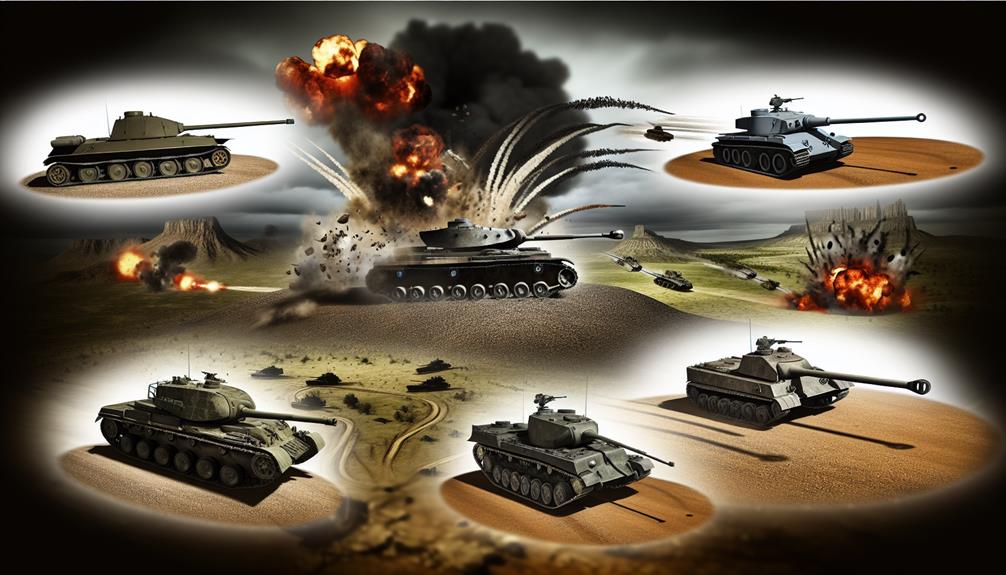
In the domain of modern warfare, distinguishing between various tank types is essential for effective strategic planning. Understanding tank classifications is important, as each type serves distinct combat roles tailored to specific operational scenarios. Broadly, tanks can be categorized into main battle tanks (MBTs), light tanks, and specialized vehicles, each designed with unique capabilities that influence battlefield dynamics. Incorporating the right strategies can enhance the effectiveness of each tank type based on the recommended exercise levels for different operational scenarios.
Main battle tanks are the backbone of armored units, combining firepower, protection, and mobility. Their role typically involves engaging enemy armor while supporting infantry operations. Light tanks, in contrast, prioritize speed and agility, making them adept at reconnaissance and rapid maneuvering in less fortified environments. Specialized tanks, such as self-propelled artillery or armored recovery vehicles, fulfill significant support roles, ensuring the primary combat units can maintain momentum and effectiveness.
Analyzing Strengths and Weaknesses
Understanding the strengths and weaknesses of various unit types is essential in developing effective strategies in the Age of Tanks. For instance, different unit types excel in diverse combat scenarios, much like how the decision to invest in cosmetic procedures such as under-eye fillers can hinge on individual needs and expectations analyzes pros and cons. Analyzing how terrain influences unit performance and positioning, alongside recognizing enemy behavior patterns, can greatly enhance tactical decision-making. By systematically evaluating these factors, commanders can optimize their forces and exploit vulnerabilities in the opposing side.
Unit Types Overview
While various unit types serve distinct roles on the battlefield, their effectiveness hinges on a nuanced understanding of their strengths and weaknesses. In the intricate dynamics of Age of Tanks, recognizing how different units excel or falter can profoundly influence your tactical positioning and overall strategy.
To optimize your unit deployment, consider the following key aspects:
- Armor Units: Exceptional at absorbing damage but often lack mobility, making them vulnerable to flanking maneuvers.
- Artillery Units: Deliver powerful long-range strikes, ideal for softening enemy defenses; however, they require protection due to their fragile nature.
- Infantry Units: Versatile and capable of seizing key terrain, but they can be easily overwhelmed by armored foes if unsupported.
Understanding these unit roles is essential for effective battlefield management. By leveraging the unique attributes of each unit type, you can devise strategies that exploit enemy weaknesses while fortifying your position. The synergy between different units can turn the tide of battle, creating opportunities for victory. Engaging with your team and sharing insights will foster a collaborative environment where strategic mastery thrives.
Terrain Impact Analysis
The battlefield's terrain plays a pivotal role in shaping strategies and influencing unit effectiveness. Different terrain types present unique environmental effects that can either enhance or hinder tactical maneuvers. Understanding map features, such as hills, valleys, and urban landscapes, is essential for strategic positioning.
Defensive structures benefit from elevated terrain, providing advantageous visibility factors that allow for early detection of enemy movements. Conversely, open terrains may present offensive opportunities, enabling rapid flanking maneuvers, but also expose units to potential ambushes.
Movement restrictions imposed by natural obstacles, like rivers or dense forests, require careful planning and obstacle navigation to maintain momentum. Identifying terrain advantages can empower commanders to dictate engagements, forcing enemies into less favorable conditions.
Moreover, the interplay of terrain and unit capabilities must be assessed; armored units thrive in open fields, while infantry excels in urban environments. By meticulously analyzing terrain impact, commanders can craft strategies that leverage their strengths against the weaknesses of opponents, ultimately leading to victory. Understanding these dynamics fosters a collective sense of belonging among players, as they share insights and experiences rooted in the intricate dance of tactical warfare.
Enemy Behavior Patterns
In examining enemy behavior patterns, one can discern critical strengths and weaknesses that shape the dynamics of engagement. Understanding these patterns allows commanders to anticipate movements and counteract strategies effectively. Significantly, enemy movement patterns often reveal tendencies that can be exploited through well-planned tactics.
Key insights into enemy behavior include:
- Ambush Tactics: Enemies may employ ambush tactics, often hiding behind terrain or structures to surprise advancing forces.
- Flank Maneuvers: Many foes utilize flank maneuvers, attempting to outmaneuver and encircle, thereby exploiting vulnerabilities in defensive formations.
- Reconnaissance Techniques: Efficient reconnaissance reveals the enemy's intent, allowing for preemptive actions against distraction ploys and surprise assaults.
Additionally, understanding retreat strategies can provide insight into an enemy's morale and readiness to engage. Observing how they respond to pressure can also lead to advantageous positioning for your own forces. By analyzing these behaviors thoroughly, commanders can craft responses that not only neutralize threats but also foster a sense of unity and strategic purpose among their troops. Ultimately, mastery of enemy behavior patterns is essential for achieving operational success in the Age of Tanks.
Terrain Utilization Strategies
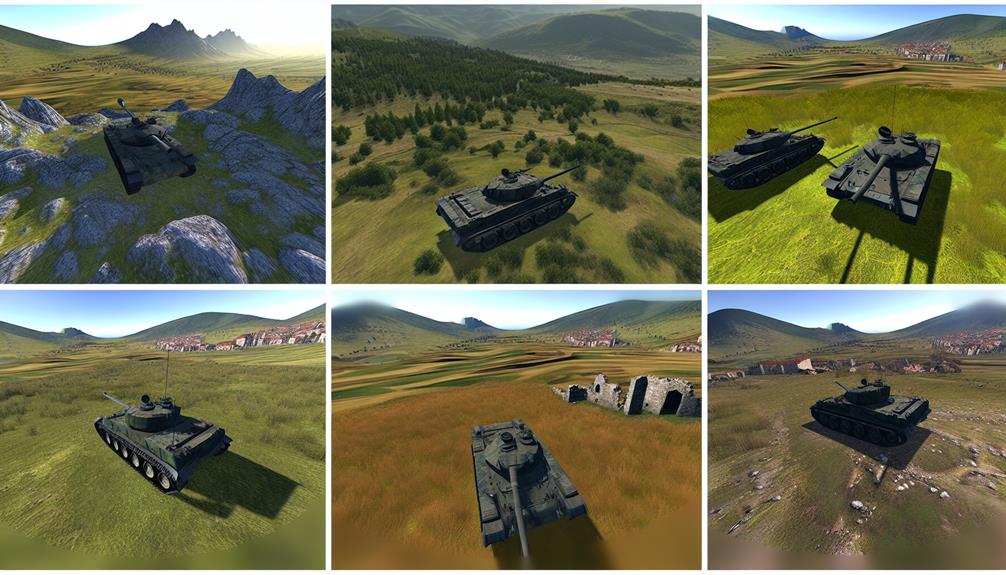
Terrain utilization is pivotal in tank warfare, where the high ground offers a strategic advantage by enhancing visibility and firing range. Additionally, effective use of cover and concealment can greatly increase a tank's survivability, allowing for tactical positioning while minimizing exposure to enemy fire. Engaging in full-body strength training can also help tank crews maintain peak physical condition, which is essential for ideal performance in high-pressure situations. Understanding these elements not only informs engagement strategies but also shapes overall battlefield effectiveness.
High Ground Advantage
Achieving a high ground advantage is a pivotal strategy in armored warfare, where elevation can considerably influence the outcome of engagements. Utilizing elevation tactics enables a commander to enhance visibility, optimize firepower, and minimize vulnerability. Strategic positioning on elevated terrain allows for the effective control of the battlefield, turning potential disadvantages into decisive advantages.
When considering high ground strategies, focus on the following critical elements:
- Enhanced Visibility: From elevated positions, you can observe enemy movements and identify targets with greater clarity.
- Effective Firepower: Tanks positioned on high ground can deliver more accurate and devastating fire, as gravity assists in projectile trajectory.
- Defensive Benefits: Elevation inherently provides a natural defensive barrier, complicating enemy advances and making it harder for them to return fire.
Cover and Concealment
Effective cover and concealment are crucial components of armored warfare, serving to enhance survivability and tactical flexibility on the battlefield. Mastering cover tactics and concealment techniques allows commanders to exploit environmental factors, thereby gaining a decisive advantage. Utilizing terrain effectively guarantees that tanks remain shielded from enemy fire while optimizing sightlines for both offensive strategies and defensive positioning.
Visibility management is critical; operators should assess the surroundings to determine which features can be leveraged for cover. Thick foliage, urban structures, and undulating terrain provide excellent opportunities for concealment, allowing for ambush planning and surprise maneuvers against adversaries. Additionally, understanding the interplay between visibility and movement can dictate the success of operations.
Incorporating cover into your tactical repertoire not only protects assets but also facilitates aggressive posturing. By maintaining optimum sightlines, you can effectively engage the enemy while minimizing exposure. As you refine your approach to cover and concealment, remember that each battlefield presents unique challenges. Adaptability and keen situational awareness are crucial, enabling you to navigate the complexities of armored engagements with confidence and precision.
Effective Resource Management
Resource management is a cornerstone of successful military strategy, especially in the context of modern warfare where armored units play a pivotal role. Effective resource allocation guarantees that each tank and supply line operates at peak production efficiency, directly impacting the outcome of engagements. A well-executed economy strategy emphasizes budget optimization, allowing commanders to prioritize assets that provide the greatest tactical advantage. Additionally, just as in military operations, engaging in gentle exercises can help maintain physical readiness and resilience, which are essential for effective decision-making in high-pressure situations.
To enhance your resource management, consider the following:
- Inventory Management: Maintain a detailed account of supplies and equipment to avoid shortages during critical operations.
- Material Conservation: Implement strategies that minimize waste, ensuring that every resource is utilized effectively.
- Supply Chain Optimization: Streamline the logistics to guarantee that resources are delivered where and when they are needed.
Team Coordination Techniques
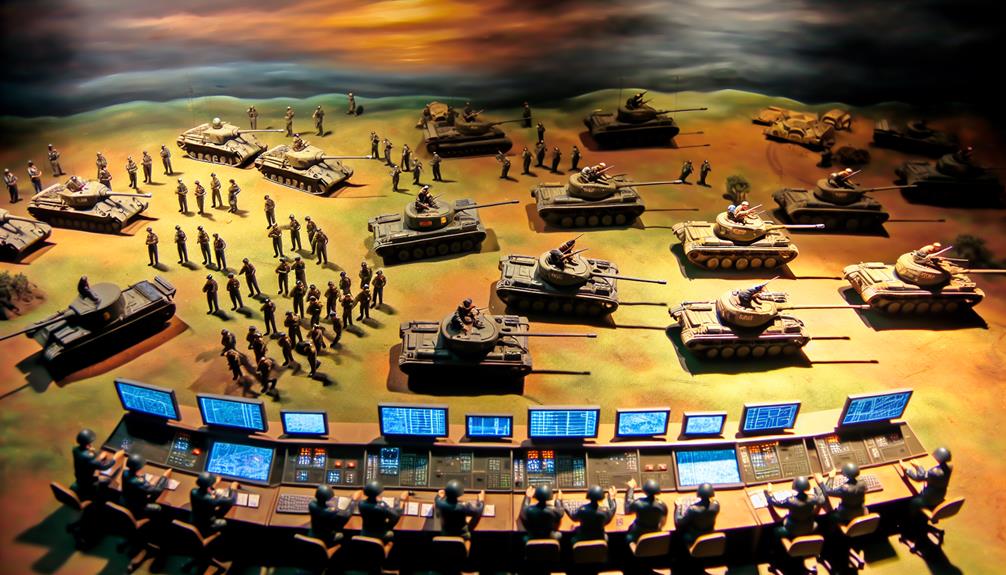
In the complex theater of modern warfare, seamless team coordination is critical for maximizing the effectiveness of armored units. Effective communication methods and precise role assignments form the backbone of successful operations, allowing teams to leverage their strengths while mitigating vulnerabilities. To enhance the bonds between team members, it can be beneficial to incorporate elements that strengthen interpersonal connections, such as practical tips for couples that encourage collaboration and understanding.
To foster a collaborative environment, teams should adopt clear and efficient communication channels, utilizing voice chat or in-game marking systems to relay critical information swiftly. This guarantees that all members are aware of enemy positions, strategic objectives, and potential threats. Additionally, regular briefings before engagements can enhance situational awareness and align tactical approaches among players.
Role assignment is equally crucial; understanding each member's capabilities allows for optimized task distribution. Designating roles such as front-line attackers, support units, and scouts creates a structure that enhances operational efficiency. Each player must embrace their role while remaining flexible enough to adapt to dynamic battlefield conditions.
Ultimately, cultivating a culture of trust and accountability within the team not only strengthens coordination but also fosters a sense of belonging. When every member recognizes their contribution to the broader strategy, the team becomes a cohesive unit capable of achieving remarkable success in the Age of Tanks.
Countering Opponent Strategies
Understanding the strategies employed by opponents is a fundamental aspect of modern armored warfare. Recognizing their tactical intentions enables you to preemptively counteract their moves, creating opportunities to outmaneuver and dominate the battlefield. Effective counter-strategies require a keen analysis of enemy patterns, particularly in the use of flanking maneuvers and ambush tactics.
To successfully counter your opponent's strategies, consider the following approaches:
- Maintain situational awareness: Constantly monitor enemy movements and predict their next actions to stay one step ahead.
- Utilize terrain: Leverage the environment to your advantage, using natural cover to thwart ambush tactics and disrupt flanking maneuvers.
- Implement counter-flanking: When faced with flanking threats, reposition your forces to create a counter-flank, effectively turning the tables on your opponent.
Adapting to Game Updates

The dynamic nature of armored warfare requires players to remain agile in their strategies, particularly when faced with game updates that can shift the balance of power on the battlefield. Understanding patch notes and their implications is essential for players aiming to stay competitive. Each update can introduce balance adjustments that directly affect the meta, necessitating a strategic evolution in gameplay.
To effectively adapt, players should consider the following aspects:
| Aspect | Importance |
|---|---|
| Patch Notes | Key insights into changes |
| Meta Shifts | Understanding new dominant tactics |
| Player Feedback | Gauging community response |
| Strategy Evolution | Adapting to new gameplay dynamics |
| Update Implications | Long-term effects on gameplay |
Training and Skill Development
How can players effectively enhance their skills in a game centered around armored warfare? Mastering the intricacies of tank operations requires a strategic approach to training and skill development. By focusing on targeted practice and assessment, players can refine their techniques and boost their performance in combat scenarios.
To optimize skill development, consider the following methods:
- Regular Gameplay Analysis: Review your matches to identify strengths and weaknesses. Utilize replays to study decision-making and tactical positioning.
- Tank Maintenance Tips: Guarantee your vehicles are in peak condition. Regular maintenance affects performance, so familiarize yourself with the mechanics and upgrades available for each tank type.
- Skill Assessment Methods: Engage in drills that challenge your tactical acumen. Simulate various combat situations to enhance adaptability and response time.
Psychological Warfare in Battles
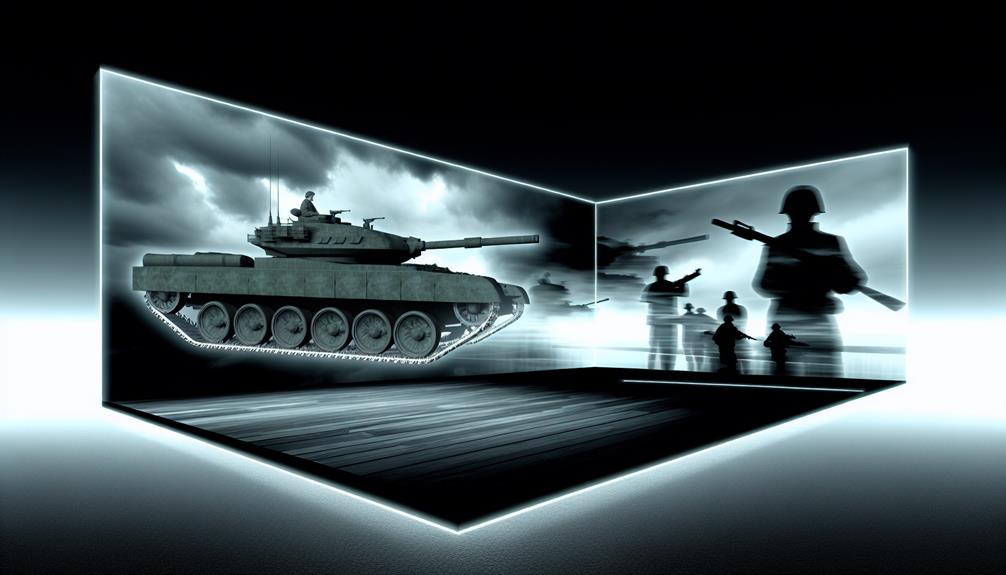
Psychological warfare plays a pivotal role in armored combat, influencing the outcomes of battles far beyond mere firepower. The ability to manipulate enemy perception and morale can be as decisive as any tactical maneuver. Utilizing deception tactics, commanders can employ feint maneuvers to mislead opponents about their true intentions, creating openings for surprise attacks that boost their own forces' confidence while instilling fear in the enemy.
The following table summarizes key psychological warfare strategies:
| Strategy | Purpose |
|---|---|
| Deception Tactics | Mislead enemy perception |
| Intimidation Strategies | Undermine enemy morale |
| Misinformation Campaigns | Control the narrative |
| Psychological Conditioning | Build resilience and confidence |
| Fear Management | Deter enemy actions |
Frequently Asked Questions
What Are the Best Tank Combinations for Different Game Modes?
Identifying the best tank combinations hinges on understanding tank synergy and game mode strategies. In offensive modes, pairing heavy tanks with support units enhances frontline durability. Conversely, in defensive scenarios, utilizing agile tanks alongside artillery can effectively control the battlefield. Adapting combinations based on specific objectives fosters a sense of belonging among team members, as cohesive strategies promote collaboration and increase overall effectiveness. Tailoring your approach to each game mode is essential for success.
How Do I Improve My Aiming and Shooting Skills?
To enhance your aiming and shooting skills, focus on mastering specific aiming techniques, such as leading your target and adjusting for bullet drop. Implementing consistent shooting drills can greatly improve your accuracy and reaction time. Regular practice under varied conditions will help develop muscle memory and precision. Additionally, analyze your performance to identify areas for improvement, fostering a sense of belonging within your gaming community as you collectively endeavor for excellence.
What Role Do Upgrades Play in Tank Performance?
Upgrades greatly impact tank performance, serving as essential tools for performance enhancement. Each upgrade can enhance various attributes, such as firepower, mobility, and armor, thereby improving overall combat efficacy. An analytical approach to selecting upgrades guarantees that players align enhancements with their tactical objectives, enabling them to maximize strategic advantages on the battlefield. Consequently, understanding the role of upgrades fosters a sense of belonging within the gaming community, as players share insights and strategies for peak performance.
How Can I Quickly Identify Enemy Tank Types?
Quickly identifying enemy tank types is essential for effective battlefield strategy. Focus on tank type characteristics, such as silhouette, size, and armament. Observing behavior patterns—whether aggressive or defensive—can also provide insights into their role in combat. Utilizing reconnaissance units or aerial surveillance can enhance enemy tank identification, allowing for timely tactical decisions. By mastering these identification techniques, teams can foster a sense of belonging, as shared knowledge enhances collective effectiveness in combat scenarios.
Are There Specific Maps That Favor Certain Tank Strategies?
Yes, specific maps often favor certain tank strategies due to their unique terrain features. Maps with open fields may benefit heavy tanks that excel in strategic positioning and direct confrontations. Conversely, maps with urban environments can provide advantages to light tanks that utilize cover for flanking maneuvers. Understanding the map terrain is essential for deploying the appropriate tank type, ultimately enhancing your team's effectiveness and fostering a sense of belonging within your strategic unit.

